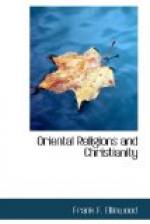FOOTNOTES:
[Footnote 80: It is by no means certain that Buddha’s followers, in carrying out his system, have not lapsed into the old notions of merit-making asceticism to greater or less extent, and have become virtually very much like the torpid and useless fakirs of the old Hinduism.]
[Footnote 81: The Jataka legends of Ceylon, dating in their present form about 500 A.D., greatly enlarge the proportions of this Northern legend, making the elephant over seven thousand miles high, and widening out the surrounding army to one hundred and sixty four miles.]
[Footnote 82: Of the Romantic Legend found in Nepaul, Beall’s translation is probably the best.]
[Footnote 83: See Appendix of Origin and Growth of Religion as illustrated in Buddhism.]
[Footnote 84: See Buddhism, pp. 110-115.]
[Footnote 85: Buddhism, p. 114.]
[Footnote 86: Pp. 265-285.]
[Footnote 87: It is the boast of the author of Esoteric Buddhism, that strange mixture of Western spiritualism with Oriental mysticism, that his system despises the tame “goody, goody” spirit of Christianity, and deals with the endless growth of mind.]
[Footnote 88: Light of Asia.]
[Footnote 89: Mr. Sinnett, in his Esoteric Buddhism, expressed the idea that it was high time that the crudities of spiritualism should be corrected by the more philosophic occultism of the East.]
[Footnote 90: The points of contact between Buddhism and certain forms of Western thought have been ably treated by Professor S.H. Kellogg, in the Light of Asia and Light of the World.]
[Footnote 91: A recent tract has appeared, entitled Theosophy the Religion of Jesus.]
[Footnote 92: Cited by Professor Kellogg.]
[Footnote 93: Professor T.W. Rhys Davids, in his introduction to Buddhism, enumerates the following sources of knowledge concerning the early Buddhism:
1. The Lalita Vistara, a Sanscrit work of the Northern Buddhists “full of extravagant fictions” concerning the early portion of Gautama’s life. Davids compares it to Milton’s Paradise Regained, as a source of history, and claims that although parts of it were translated into Chinese in the first century of our era, there is no proof of its existence in its present form earlier than the sixth century A.D.
2. Two Thibetan versions, based chiefly on the Lalita Vistara.
3. The Romantic Legend, from the Sanscrit of the Northern Buddhists, translated into Chinese in the sixth century A.D.; English version by Beal published in 1875. This also is an extravagant poem. This and the Lalita Vistara embrace most of the alleged parallels to the Life of Christ.
4. The original Pali text of the Commentary on the Jatakas, written in Ceylon probably about the fifth century of our era. Davids considers its account down to the time of Gautama’s return to Kapilavastu, “the best authority we have.” It contains word for word almost the whole of the life of Gautama given by Turnour, from a commentary on the Buddhavansa, “which is the account of the Buddhas contained in the second Pitaka.”




